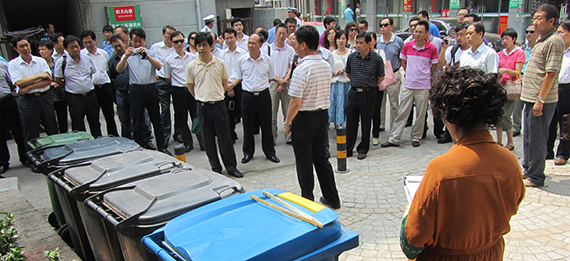Twice a day, Beijing's Chaoyang Circular Economy Industrial Park carefully sweeps a waste site in Gaoantun. Benches and trees give the site a park-like feel. Citizens are invited to tour -- and smell -- the facility.
Meanwhile, a model landfill in Hangzhou attracts tens of thousands of tourists with a "trash tour" of its trash-to-gas power plant, environmental video games and an eco-park the size of 10 football fields that sits on a mountain of trash generated by the city's 3 million residents more than a decade ago.
Waste management was the "It girl" in 2011 for sustainability issues for the Chinese government. That year, my organization JUCCCE conducted a 7-day training course for 50 Chinese mayors on municipal waste treatment.
Why is trash generating all this interest in China?
The answer is simple: waste is a huge and growing problem in China that is overwhelming cities.
JUST HOW BIG IS CHINA'S WASTE PROBLEM?
In 2012, Beijing had a population of 21 million, and produced 17,400 tons of solid waste per day. Seventy percent of this waste was simply buried. This is like burying over 6,000 mid-sized cars (by weight) every single day in one city alone. By 2030, China is predicted by the World Bank to produce 480 million tons of solid waste each year. That's the equivalent of throwing away about 60 million yellow school buses every year.
These numbers don't even include 8 million tons of electronic waste that is smuggled into China each year and cause carcinogenic pollutants to seep into soil and groundwater. According to China Business News, the final destination of around 70 percent of the world's annual 500 million tons of e-waste is China.
Of course, there are a lot of other types of waste, in addition to the solid waste you see in landfill. There's sewage sludge, agricultural waste, emissions, marine waste, liquid waste, heat waste and more. China frankly has not addressed any of these adequately.
WHERE IS ALL THIS SOLID WASTE GOING?
In 2010, China only had 919 licensed landfills that have passed environmental inspections, compared to more than 2,000 total landfills in the UK.
Much of China's trash is illegally dumped in unofficial landfills and heaps that are not operated properly and leak pollutants into the ground, water and air. The stench from rotting garbage is also nauseating.
The Beijing Municipal Commission of City Administration and Environment has vowed to address 250 of the landfills that are illegally operated. This type of treatment will be resource intensive: trash has to be dug up and incinerated; the bottoms of landfills need to be lined to prevent leakage; poisonous methane gas must be captured. By 2015, Beijing aims to cut the share of landfills from 70 percent to less than 30 percent of the total waste stream. Waste generated in the future will be sent to 40 newly built incineration plants, food waste facilities and other kinds of waste handling facilities.
WET FOOD WASTE IS ONE OF THE LARGEST CHALLENGES
In Mainland China, up to 70 percent of all waste is wet food waste. This is problematic because food decomposition is a huge producer of methane in landfills. As a comparison, the percentage of organic waste is 23 percent in the US, 25 percent in France, and 37 percent in Denmark.
The water content makes wet food waste difficult to incinerate with current technologies. In addition, Asian food is often covered in cooking oil that creates a barrier to decomposition. Separating compostable food waste is not a common practice among kitchens. As a result, most of the food waste is going to landfill unnecessarily.
Without a proper channel of food waste disposal, much of the waste gets fed to pigs, which causes people to fear that cannibalism might create disease. In fact, Britain blamed Europe's foot-and-mouth epidemic on contaminated meat that was fed to hogs there. Another area of public concern is that oil and grease in the food waste are often illegally collected and sold back to the restaurants, and therefore eventually, to the customers.
China is currently ill-equipped to build their goal of 242 food waste handling plants nationwide before 2016.
WHERE CAN CHINA LEARN FROM?
We want to move towards a method of waste collection that requires people to prepay for collection by buying official waste collection bags of different types at the nearest convenience store. In Tokyo, Taipei and Seoul this has proven to reduce waste volume dramatically as well as increase recycling volume.
In Singapore, a new technology called PIGS or Prodigy Intelligent Gas System is turning kitchen waste into gas for cooking and fertilizer. It's an old technology that is commonly used in places like Sweden, but is now being adapted to urban areas such as Thailand's famous floating market.
My recent visit to the Tzu Chi Buddhist Foundation recycling centers in Taiwan impressed me with their large populations of elderly and mentally disabled regaining a sense of life purpose and community by volunteering to recycle each day. The plastic is turned into blankets for disaster relief victims and clothing sold for charity.
Ultimately, waste is not going to be solved solely by technology. We need to fix a behavior problem. As China's population grows and its consumers have more disposable income, we need to reduce the amount each person is throwing into the trash; we need to rethink our straight-into-trash purchasing mentality; and we need to respect waste as a valuable resource that we can reuse.